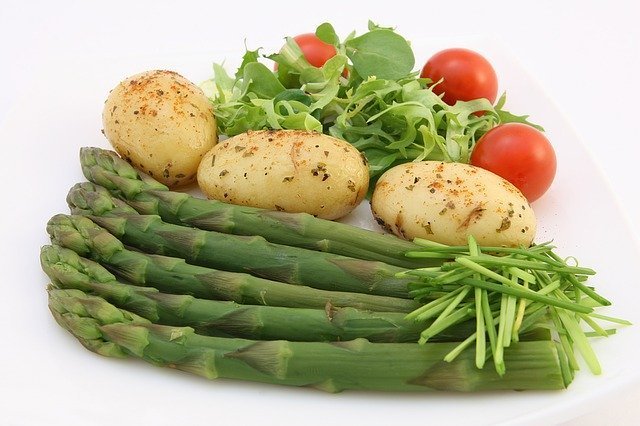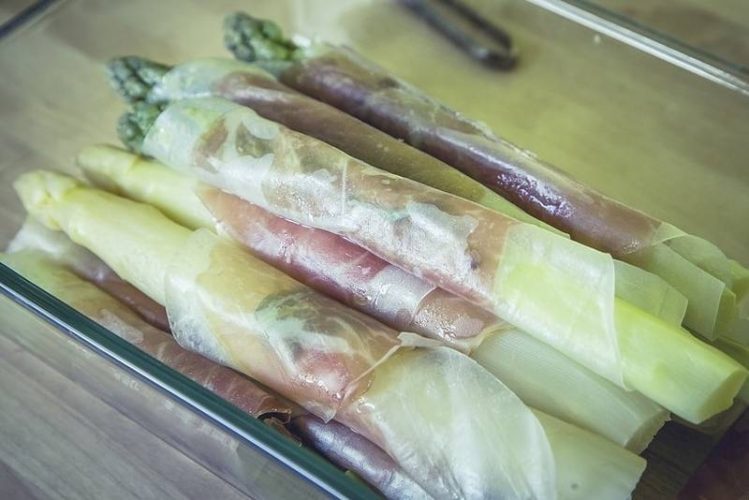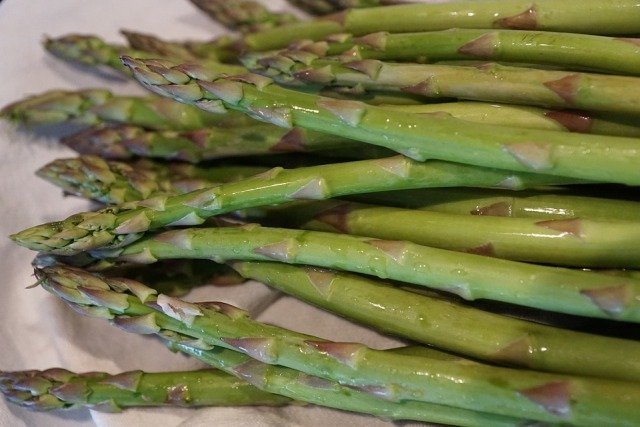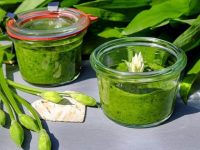When I was little, my father and I used to drive to an asparagus farmer every Saturday from the beginning of April, when the asparagus season started. Every Sunday there was asparagus for lunch. This lasted until June 24th. On this day, the “Johannesnacht” marks the traditional end of the asparagus harvest in Germany.
No, I never got tired of eating my mother’s asparagus dishes. But even though it tastes so good, what is asparagus good for? Is asparagus a superfood?

A Short History Of Asparagus
Asparagus is a genus of flowering plants in the family Asparagaceae. More than 200 species are known, most of them are ornamental plants.
Garden Asparagus (Asparagus Officinalis) is the one we eat each spring. We consume the green or the white version, but both are the new shoots of the same plant. You get white asparagus by covering the plant with soil so that it is not exposed to the sunlight, therefore photosynthesis cannot happen. They are picked just when the top of the plant is about to break the soil. Green asparagus is allowed to grow in the light and is picked when it is about 8 inches long.
The plant originates from Eurasia, from there it spread to Middle – and Western Europe, as well as to Northern Africa. Asparagus was known to the Greeks already 2500 B.C. but mainly used for medical reasons. Apparently, the ancient greek thought it is good for treating toothache and bee stings, but would also be beneficial for the skin. The Romans cultivated asparagus and consumed this vegetable on a regular basis.
In the 17th century, asparagus found its way into the European royal houses. It was grown in the castle’s gardens and was on the menu when special guests were invited.

What Is Asparagus Good For?
Asparagus is full of valuable nutrients and goes well as a side dish with meat, fish, or even vegetarian dishes.
You can eat it raw or cooked, warm or cold, as a salad, in a creamy soup, in stews, in vegetable stir-fries, or in delicious curries, asparagus is always a treat.
Only 4 percent of the asparagus are carbohydrates and 0.2 percent fats. About 2 percent are proteins and the rest, about 93 percent is water, therefore it has very few calories only. 3 oz of the cooked vegetable only contains about 20 kcal (52 kJ).
There are lots of good minerals and vitamins as well as a whole load of trace elements in it.
Minerals
- Potassium: helps lower the blood pressure and is also important for the proper functioning of nerve stimulation.
- Calcium: is essential to teeth and bones.
- Phosphorus: is also an important building block for the bones and a good source of energy.
Vitamins:
- Vitamin A: is good for your eyesight and inhibits oxygen radicals.
- Vitamin E: essential for the nervous system and its role to protect our cells from free radicals.
- Vitamin K: is important for the blood, and bone metabolism.
The vegetable is well known for its diuretic effect, which is mainly due to Asparagusic Acid. This amino acid promotes kidney activity and simply makes you want to pee.
Because of the combination of low calories and the diuretic effect asparagus is good if you want to drop a few pounds and it may help if you are suffering from dropsy.

Can You Eat Asparagus When Suffering From Gout?
There is some discussion about eating it when you suffer from gout because it contains purines. Those are chemical compounds found in many foods. Uric acid is produced when the purines are broken down from the food. This can create an excessive high uric acid level in the blood. This, in turn, can lead to deposits in joints and thus to gout.
But purines are not only found in vegetables, but they are also in meat, poultry, offal, fish, shellfish, crustacean, and soy products. You find purines also in alcoholic and non-alcoholic beverages.
Thus, the overall composition of a meal .. meat, vegetable, sauce, beer, is probably more dramatic than a serving of asparagus. If you suffer from gout and you do not want to forgo asparagus, then combine the asparagus with low purine food such as eggs, potatoes, brown rice, wholemeal products, green salads, lean poultry, skin removed.
Green Or White?

I grew up with the white variety of Asparagus which is more popular in Germany and much of Europe. Whether white or green asparagus is preferred depends largely on local traditions, with many North Americans preferring the green asparagus. But I like both because they come into their own in different dishes.
If you compare the taste of both varieties, you will find that green asparagus tastes heartier and stronger than the white version. Also, because of the chlorophyll that gives it its color, the green variety contains more vitamins and is much easier to clean.
With fresh green asparagus, it is usually sufficient to use a sharp knife to cut off the slightly woody ends (often a white-purplish color) as their skin is very tender. If necessary, you can scrape off the skin at the lower third of it with a sharp knife. The waste is little.

White asparagus has fibrous, hard skin and must therefore always be peeled before cooking. You need to use an asparagus peeler. Place a peeler directly under the delicate head of each spear and pull off the peel all around. Apply a little more pressure from the lower third, because towards the end the stalks often become even more woody. The woody part at the end must be cut off completely. When they are very fresh it is enough to cut off half an inch, if the spears are not quite as fresh anymore you may need to take away 1 to 2 inches. If you notice that long fibers can still be removed, you should peel them again. You get much more waste with white asparagus. But don’t throw the peel and cut-offs away. Use those for the base of cream soup. Quite a delicacy.
Of course, you can buy already peeled white asparagus, however, it will be so more expensive.
I like both varieties, for me, it is important that I have a fresh seasonal and local product that makes a delicious meal.
Asparagus FAQ
What is the difference between white and green Asparagus?
Whether it’s green or white asparagus, it’s the same plant – Asparagus officinalis, but the harvest takes place at different stages of growth.
The green asparagus gets it color from the sun’s rays. When it breacks the surface and grows above ground, it develops the green chlorophyll that is necessary for photosynthesis (= generating energy through sunlight).
However, white asparagus grows underground. If we would not cover it with a black foil, it would also turn green. The foil prevents them from producing chlorophyll.
Even if both asparagus could be “green”, different specialized varieties are used for professional cultivation.
Can you reheat asparagus?
Yes, you can reheat cooked asparagus without having to worry about your health. Asparagus is a low-nitrate vegetable and therefore does not form toxic nitrite when stored for a long time and reheated.
Pay attention to these points when warming up asparagus:
- Asparagus dishes should be stored in the refrigerator and not at room temperature.
- Leftovers should be used up within 24 hours.
- Reheat the asparagus only once.
- Make sure to reheat the dish to more than 70 degrees to kill off pathogens.
What if I store asparagus incorrectly before reheating?
If you have eaten a small amount of asparagus that is too old or improperly stored, it will not affect you negatively. However, if you eat a large portion, your body tries to get rid of the toxins, causing diarrhea, nausea, and vomiting.
How to store asparagus properly
Asparagus tastes best the sooner it is prepared after harvest. If you cooked too much and have any leftovers, you can store them in an airtight container in the fridge for a few days.
Bought too much fresh asparagus and don’t want to cook it all at once, you can store it in the fridge. Just wrap it in a damp kitchen towel and put it in the vegetable box at the bottom of the fridge and it will keep for a few days to a week
Want to enjoy it after the asparagus season, just freeze the asparagus. Simply cut green asparagus into 2 inch long pieces, put them in an airtight container, and put them in the freezer. The best way to keep white asparagus is to blanch it in water for a very short time before you freeze it. In an airtight container, frozen, it keeps for several months.
Recipe: White Asparagus With Prosciutto And Red Potatoes
- Cook Pork Shoulder In A Crock Pot - August 28, 2022
- 10 Easy and Delicious Italian Ground Beef Recipes - July 2, 2022
- Homemade Italian Meatballs - June 25, 2022




